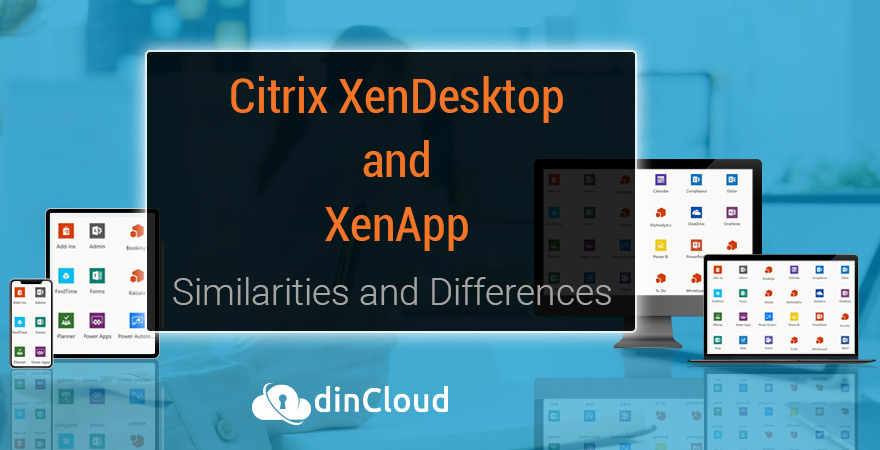As a leading provider of Cloud Hosted Solutions, dinCloud has been collaborating with some of the cloud industry’s best names. Citrix is one of those names in the industry, resulting in dinCloud being a Citrix Partner as a Premier Service Provider.
At dinCloud, we believe in delivering the full range of cloud solutions to our valuable users, whether it is Citrix or any other high quality cloud environment. However, people tend to confuse the concepts of Citrix XenDesktop and Citrix XenApp.
In this post, we will discuss how both of these Citrix solutions work, and what are the similarities as well as contrasting elements of these two solutions.

Related: Best Desktop as a Service (Daas) Provider
Intro to XenDesktop and XenApp
The Citrix Virtual Desktop services are offered under the XenDesktop brand name, while Citrix Virtual Applications are branded as XenApp. XenDesktop (XD) is the desktop virtualization software by Citrix.
XD is a multi session virtual desktop offering by Citrix, which gives a single user access to virtual desktops. The main benefits of XD include centralized management of desktop environments through a unified data center, cost reduction and better security.
XenApp (XA) on the other hand, gives multiple end users access to shared resources, such as an enterprise application. In both cases, the resources of the Cloud Service Provider (CSP) are used to deliver either Virtual Desktops or Virtual Applications.
Related: 10 Benefits of Desktop-as-a-Service (DaaS) You Don’t Want to Miss
Similarities b/w XenDesktop and XenApp
The common perception is that XenDesktop is meant exclusively for using and accessing virtual desktops, while XenApp is meant exclusively for using virtualized applications. However, both XD and XA can give users access to hosted apps as well as desktops.
How are XenDesktop and XenApp Different?
The main difference between XenDesktop and XenApp lies in the way both of these solutions are executed or structured. In the case of XD, a user has exclusive access to a virtual desktop environment, which can run on a Windows operating system.
As the user has exclusive access in the case of XenDesktop, such a user will be able to access and use multiple applications at the same time. In the case of XenApp however, multiple users will share the same computing resources like CPU, RAM and GPU etc.
Related: Hosted Virtual Desktop Overview, Benefits & Use Cases
When to Deploy XenDesktop and XenApp?
So, the next logical question is, when is it suitable to use XenDesktop, and when should XenApp be used. Well, this will depend on the specific use case. Let us discuss this issue, so that our valuable users can develop a better understanding.
XenDesktop (XD) is a suitable deployment option when, not only are your users physically dispersed, but they are also handling processing intensive workloads. Such workloads require exclusive processing resources, offered only by XenDesktop.
XenApp (XA), on the other hand, is recommended for small to medium sized enterprises (SME), where the number of users could be higher, but the nature of tasks is repetitive and not that much resource intensive. In such cases, even shared resources can be sufficient.
In such repetitive use cases, where the workloads are also not resource intensive, XenApp delivers an optimal balance of cost and productivity. XenDesktop can justify their higher cost for resource intensive workloads, where the expected gains are also substantial.
Related: Co-relation between Platform as a Service & Virtual Desktop
Conclusion
Whether you use XenDesktop (XD) or XenApp (XA) will depend on the specific use case your enterprise wants to accomplish. Regardless of that, virtualization solutions offer a lot of benefits to enterprises in terms of costs, flexibility, agility and ease of management.
Contact dinCloud for cloud hosted desktop and application solutions that are secure, affordable and reliable.


